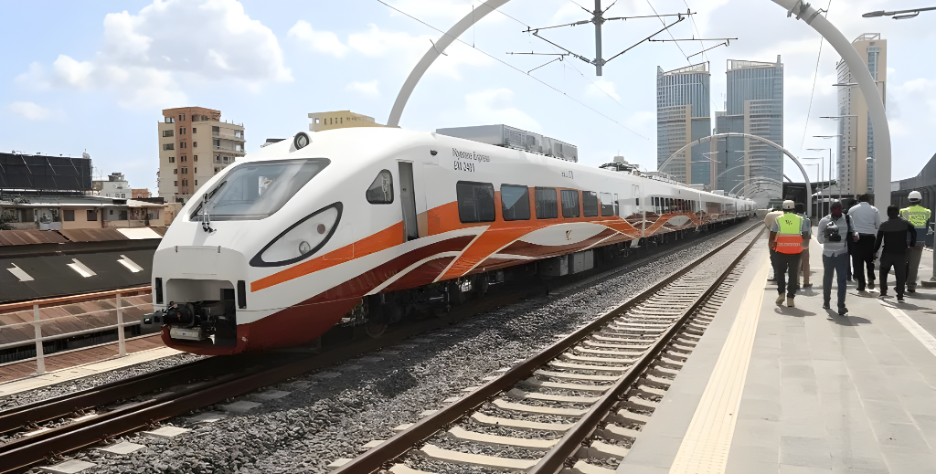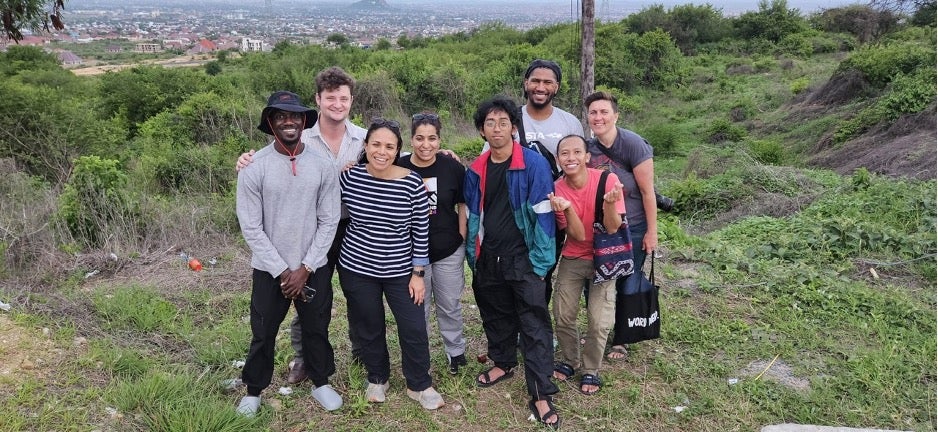TZ Winter Amp Day 2
Day 2: Sun Jan 5 - Travel to Dodoma and Visit Dodoma markets
Journey Through Tanzania’s Heartland
By Chuck Baker
The day began in the heart of Dar es Salaam at the CBD Hotel, where breakfast was a culinary tapestry of local and international flavors. Grilled sweet potatoes, baked beans, pancakes, and even BBQ chicken stood side by side on the buffet, reflecting the hotel’s effort to cater to its diverse clientele. But it was the local foods such as corn Mkate wa Mayai (Egg Cake) that stole the show for me—light, subtly sweet, and with a texture that could only be described as perfection. It was the kind of bite that sticks in your memory, so naturally I wrapped a slice to take on the journey ahead.
 Photo 1: The fully electric Standard Gauge Railway train, revolutionizing travel between Dar es Salaam and Dodoma with speed, efficiency, and sustainability. Image credit: Tanzania Invest
Photo 1: The fully electric Standard Gauge Railway train, revolutionizing travel between Dar es Salaam and Dodoma with speed, efficiency, and sustainability. Image credit: Tanzania Invest
The next chapter of our adventure began at the Standard Gauge Railway (SGR) station. This wasn’t just a mode of transportation—it was a symbol of Tanzania’s leap into modernity. The SGR, East Africa’s first fully electric railway, links Dar es Salaam to Dodoma, covering over 500 kilometers with a sleek design and cutting-edge technology. As we settled into the train’s spacious, air-conditioned carriages, the hum of the electric engine quietly announced that this was no ordinary train ride. Built by a consortium of international companies, including Yapı Merkezi, the railway is a feat of engineering, bringing a new level of speed and efficiency to a country on the move.
Leaving the city, the train surged forward, and the sprawling urban landscape quickly gave way to the tropical savannah. The scenery shifted with every mile—palm trees and acacias dominated the foreground, while the horizon danced with hazy hills. Villages like Dakawa and a large inland city called Morogoro, flashed by, their thatched-roof huts and bustling marketplaces offering fleeting glimpses of daily life. If you looked closely, you could catch the lingering fascination on the faces of locals along the train's path, their smiles and enthusiastic wonder reflecting the universal delight sparked by humanity’s progress.
The terrain became more dramatic as we moved inland. The vibrant greens of the coast softened into the muted yellows and browns of the semi-arid Dodoma region, where the land stretched out in an endless patchwork of fields and scattered acacia trees. January (the cloudiest month of the year in Dodoma) brought with it a thick canopy of gray skies, occasionally pierced by shafts of sunlight that painted the landscape in a golden hue. The contrast was stunning, a play of light and shadow that seemed almost theatrical.

Photo 2: Through the train window: A serene glimpse of Tanzania's lush palm groves and the distant silhouette of the Ukaguru Mountains, as the journey to Dodoma unfolds.
The Ukaguru and Nguru mountain ranges rose in the distance as we approached Dodoma. The city, nestled in the heart of Tanzania’s central plateau, lies between 1,200 and 1,500 meters above sea level. Its semi-arid climate is shaped by erratic rainfall and stark temperature swings—blistering afternoons often give way to brisk, chilly nights. The land here is both rugged and resilient, a fitting backdrop for a region that’s home to a rich tapestry of ethnic groups, from the Gogo to the Rangi, each contributing to the area’s unique cultural mosaic.
The train eased into the SSH SGR Railway Station in Dodoma after a smooth four-hour journey. With its population density of around 60 people per square kilometer, the city felt spacious yet alive. A short drive brought us to Domiya Estates Ltd., a former wine factory turned into a vineyard and bed-and-breakfast. The estate welcomed us with its sprawling courtyard gardens, lush courtyards, and a crystal-clear pool being the source of entertainment from occupants enjoying themselves. From here, the view of the surrounding landscape—semi-desert plains punctuated by rocky escarpments—was striking. It reminded me of the rugged beauty of the Rocky Mountains in Colorado, a parallel that felt both unexpected and oddly comforting.
After settling in and taking a moment to ourselves, we ventured into Dodoma’s bustling markets. The Saba Saba and Machinga markets were vibrant and full of life, with vendors hawking everything from freshly harvested mangoes to intricate beadwork and carvings. The aroma of diverse meals and the sound of lively bartering filled the air… a sensory overload, the kind of energy that made you feel connected to the pulse of the city. There was one vendor that caught our attention - fresh sugarcane. Stripped and cut into bite-sized sticks, the cane was both sweet and refreshing, its natural juice bursting with flavor as we chewed.

Photo 3 - Overlooking Dodoma: From left to right—John, Chuck, Rianna, Ash (Aishwarya), Gerry, Damani, Fahmi, and Fid
Afterwards, we made our way to an overlook above Dodoma, where the city unfurled its canvas below us. The prominent terracotta rooftops framed by the dramatic contours of the Rift Valley escarpment brought a moment of quiet awe, the kind that reminds you of how vast and varied the world is. Overhead, the partly cloudy sky offered glimpses of rain shafts in the distance and brewing storm cells gathering just south of us—an ominous yet mesmerizing sight that hinted at the weather to come. As the sun dipped below the orange and pink horizon, we returned to Domiya Estates to spend our evening swimming, enjoying dishes made from the estate’s own fresh produce, and sharing stories under a warmly lit balcony. The earthy scent of rain intertwined with the lingering aromas of the vineyard, while the distant rumble of thunder set a rhythmic backdrop to our stories and laughter. It was a fitting conclusion to a day that balanced discovery and quiet reflection in equal measure.
